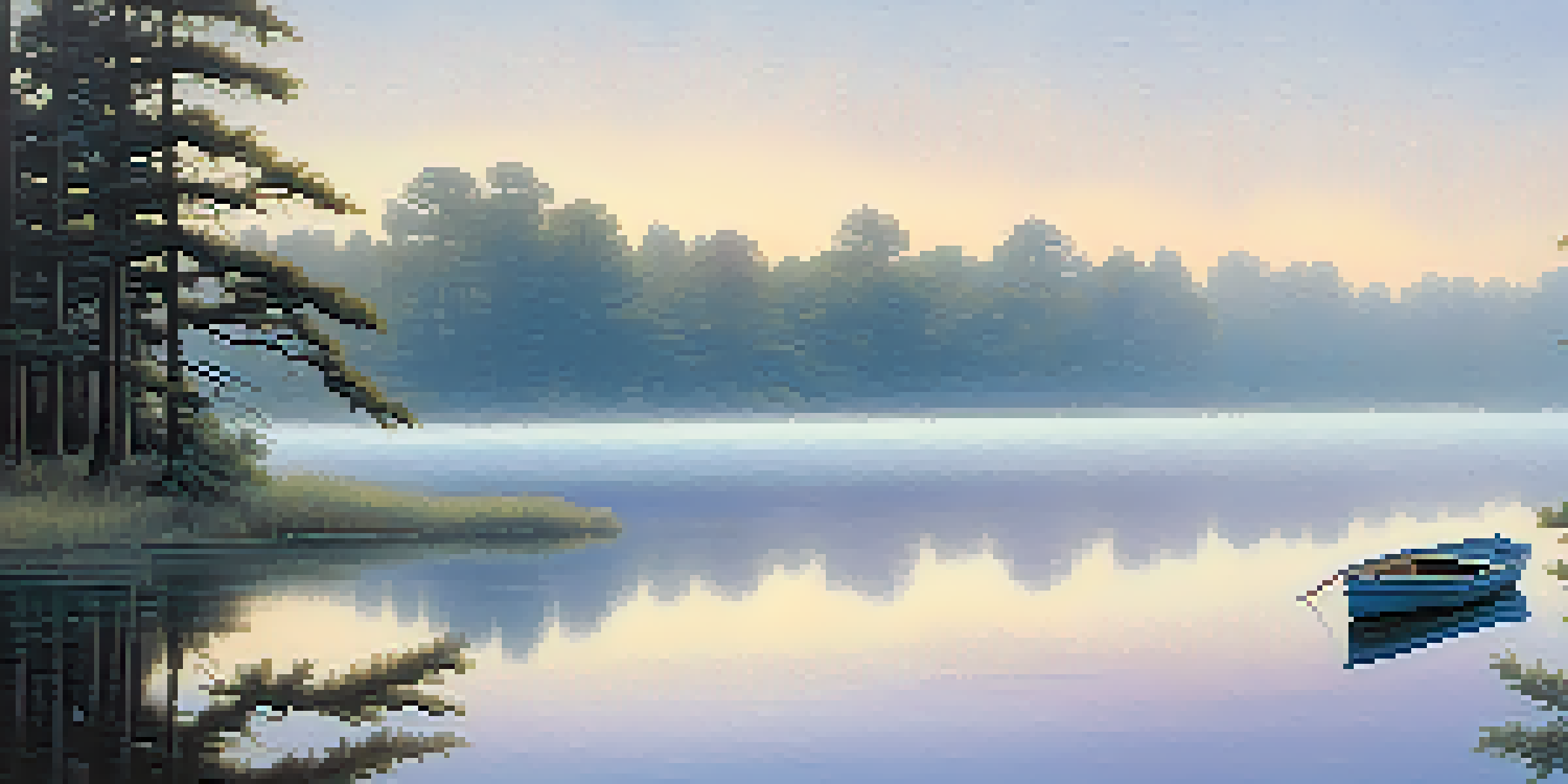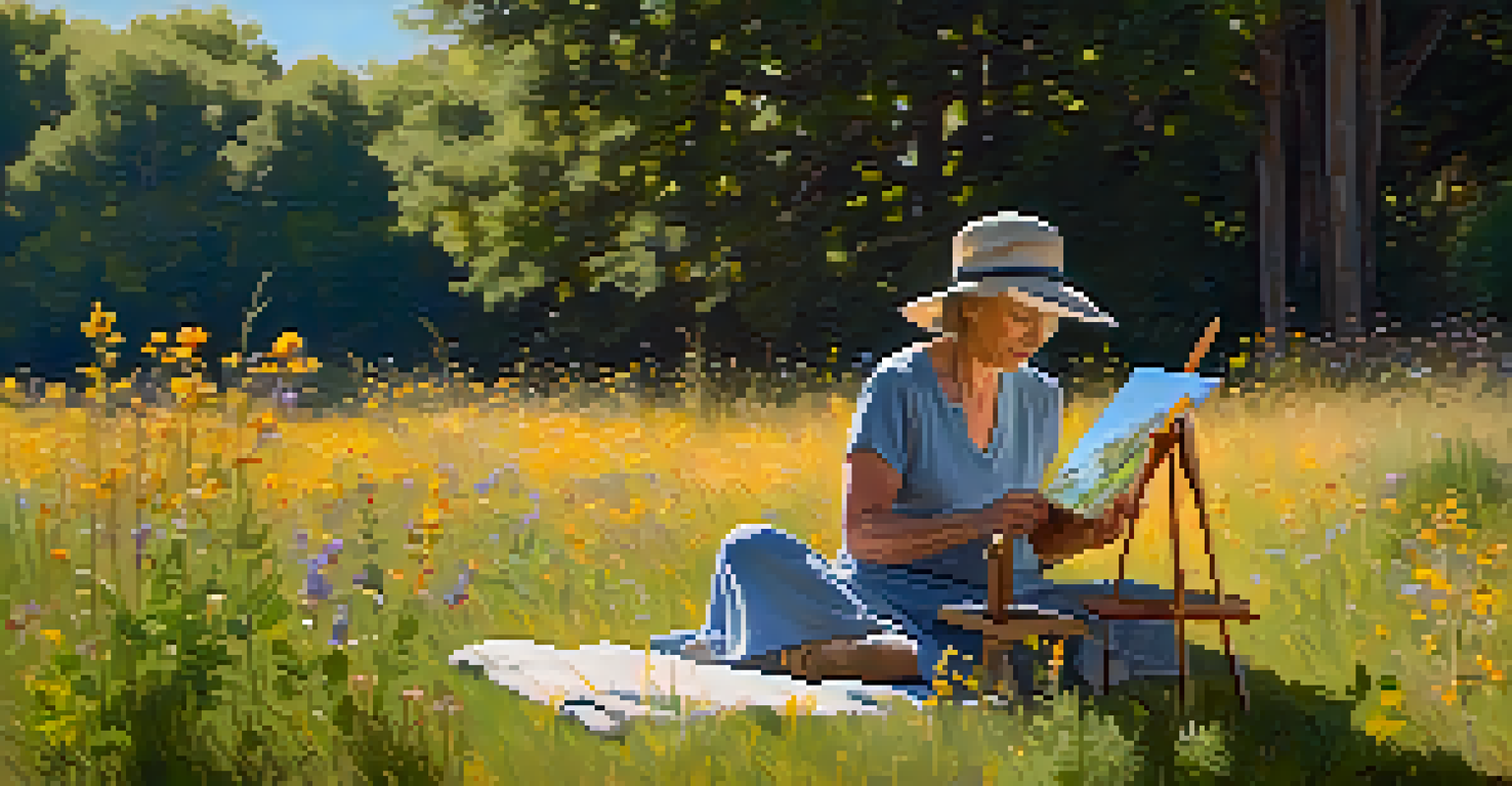Exploring the Impact of Natural Light on Painting Techniques

Understanding Natural Light and Its Characteristics
Natural light, coming from the sun, has unique qualities that change throughout the day. This light can affect the mood and atmosphere of a painting, creating different effects depending on the time and weather. Artists must understand how natural light varies in color temperature and intensity to utilize it effectively in their work.
Light is the magical ingredient that brings life to any work of art.
For instance, morning light is often cooler and softer, while midday light is bright and harsh. These changes can influence how colors appear on the canvas, making some hues look vibrant while others fade into the background. By observing these shifts, artists can choose the best times to paint and create more dynamic pieces.
Incorporating natural light into painting techniques not only enhances a piece's realism but also allows for emotional depth. Different lighting can evoke feelings of warmth, melancholy, or even tension, making the artwork resonate with viewers in diverse ways.
The Role of Shadows in Painting
Shadows are an essential aspect of painting that adds depth and dimension to a piece. Natural light creates shadows that change in size and intensity, which can dramatically affect the overall composition. Artists often use these shadows to guide the viewer’s eye and create focal points within their work.

For example, a strong shadow cast by a tree can lead the viewer’s gaze toward a hidden figure in the background, adding layers of intrigue. Understanding how to portray shadows accurately requires observation and practice, as each light source will create unique shadow shapes and patterns.
Natural Light Shapes Artistic Mood
Artists must understand the variations in natural light throughout the day to effectively influence the mood and atmosphere of their paintings.
By mastering the interplay of light and shadow, artists can elevate their paintings from mere representations to powerful visual narratives. This technique can transform a simple landscape into a breathtaking scene alive with movement and emotion.
Color Perception Altered by Natural Light
The perception of color can vary dramatically based on the quality of natural light. Colors can appear warmer in golden hour light, while they may seem cooler during overcast days. This phenomenon means that an artist's palette may need to adapt depending on the lighting conditions they’re working in.
Color is the keyboard, the eyes are the harmonies, the soul is the piano with many strings.
Take, for example, the way an artist might paint a sunset. The soft oranges and pinks can become vibrant and rich in the warm glow of evening light, while the same colors can look dull if painted under harsh midday sun. This understanding helps artists make informed decisions about their color choices and how to apply them.
Incorporating the effects of natural light on color perception enables artists to create more lifelike and emotionally resonant works. It invites viewers to experience the artwork in a way that feels genuine and connected to the world outside.
Techniques to Capture Natural Light in Painting
There are several techniques artists can use to capture the essence of natural light in their paintings. One popular method is plein air painting, where artists create works outdoors, directly observing the light and its effects on their subjects. This practice encourages spontaneity and helps artists respond to the environment in real-time.
Another technique is glazing, where thin layers of transparent paint are applied to build up color and depth. This allows the artist to mimic the way light interacts with surfaces, creating a sense of luminosity that feels vibrant and alive. By layering colors, artists can achieve a more dynamic interplay of light and shadow.
Shadows Add Depth and Focus
The interplay of light and shadow is crucial in painting, guiding the viewer's eye and enhancing the overall composition.
Experimenting with different techniques can lead to unique results and a deeper understanding of how to manipulate light in art. Each approach offers opportunities for creativity and innovation, helping artists to refine their skills and develop their signature styles.
The Influence of Geography on Light Quality
Geography plays a significant role in the quality of natural light experienced in different regions. For instance, artists in coastal areas may observe a softer, diffused light due to moisture in the air, while those in desert regions experience more intense, direct sunlight. These environmental factors can shape an artist's style and technique.
Consider how the Impressionists were inspired by the unique light of locations like Giverny or Venice. The variations in light not only influenced their color choices but also the brushwork and compositions they employed. Each geographic location offers distinctive light qualities that can enhance the artistic experience.
By exploring the local light conditions, artists can develop a deeper connection to their surroundings and incorporate this into their work. Understanding these nuances can lead to more authentic and relatable art, reflecting the artist's unique perspective.
Art Movements Inspired by Natural Light
Throughout art history, various movements have emphasized the importance of natural light, significantly influencing painting techniques. The Impressionists, for instance, focused on capturing fleeting moments of light and color, often painting en plein air to observe nature firsthand. Their approach marked a departure from traditional methods, prioritizing light's changing qualities.
Similarly, the Barbizon School aimed to depict the beauty of rural landscapes under natural light. Artists like Jean-François Millet worked to capture the essence of the countryside, emphasizing the interplay of light and shadow to create a sense of harmony between humanity and nature. This connection is a hallmark of their style.
Geography Affects Light Quality
Different geographic locations provide unique qualities of natural light, influencing artists' styles and techniques.
Understanding how these movements utilized natural light can inspire contemporary artists to experiment with their techniques. By learning from the past, artists can develop their own unique styles while continuing to explore the impact of natural light on their work.
Conclusion: Embracing Natural Light in Art
In conclusion, natural light profoundly impacts painting techniques, shaping how artists perceive and represent their subjects. From capturing color variations to understanding shadows, the nuances of light can transform a simple painting into a powerful visual experience. By embracing natural light, artists can enrich their work and create pieces that resonate with viewers.
Furthermore, the connection between geography, art movements, and light quality offers endless inspiration for artists at all levels. Whether painting outside or experimenting with techniques like glazing, the possibilities are vast and exciting. Artists are encouraged to explore their environments and let natural light guide their creative processes.

Ultimately, the journey of discovering how natural light influences art is ongoing. By remaining open to its effects, artists can continuously evolve their techniques and create works that reflect the beauty of the world around them.